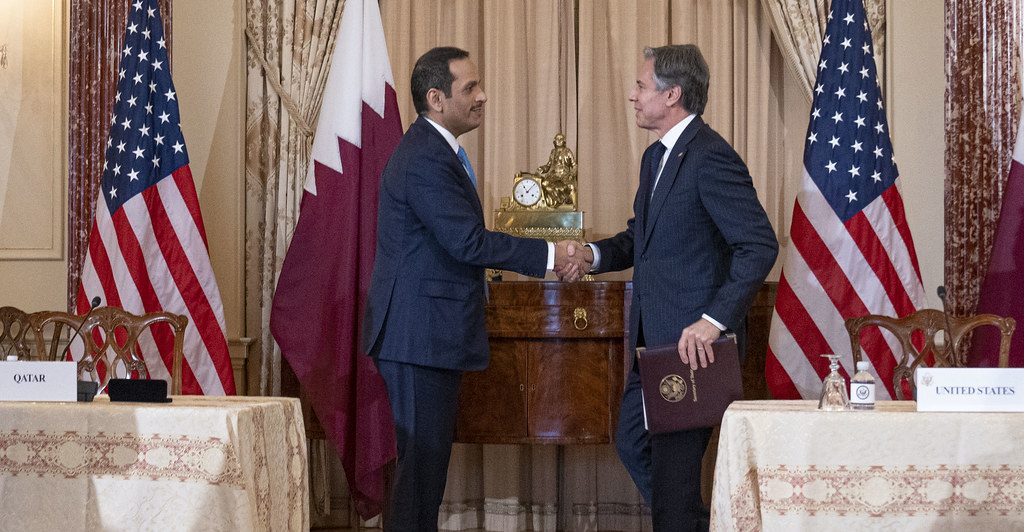The UN said on Sunday that at least 852 trucks have since crossed over to Gaza, though none of them contained much-needed fuel to power the Palestinian enclave.
Foreign ministers of Qatar and the United States discussed the evacuation of “the critically wounded” from Gaza and the continuation of aid flow into the enclave on Sunday, as the Strip faces a worsening humanitarian catastrophe.
The matter was discussed in a phone call between Qatar’s Prime Minister and Minister of Foreign Affairs Sheikh Mohammed bin Abdulrahman Al-Thani and US Secretary of State Antony Blinken on the developments in Gaza.
“They discussed ongoing efforts to evacuate the critically wounded and urgently increase the flow of humanitarian aid into Gaza. Secretary Blinken and Prime Minister Al Thani also discussed efforts to ensure the safe passage of foreign nationals out of Gaza and the immediate and safe return of all hostages,” read a State Department statement on the call.
A separate statement by Qatar’s foreign ministry said that Sheikh Mohammed “underscored the need for concerted regional and international diplomatic efforts to reach an immediate ceasefire and to permanently open the Rafah crossing to ensure the flow of relief and humanitarian aid.”
“His Excellency stressed the State of Qatar’s continued mediation efforts to release hostages, noting that the continued bombing doubles the humanitarian catastrophe in the Strip and complicates the efforts being made,” the Qatari statement added.
Along the Egypt border, Qatar has been working to keep the Rafah crossing open to allow for the entry of aid and exit of foreign nationals and patients.
The crossing has been predominantly shut for regular traffic since the start of the war on October 7 following multiple Israeli attacks. Egypt said it requires a green light from Tel Aviv to open the crossing.
However, it opened on November 1 for the first time to allow the exit of foreigners and the critically wounded, a breakthrough that was achieved following Qatari and Egyptian efforts.
Since then, hundreds of foreign nationals have been evacuated through the crossing after spending weeks trapped inside Gaza. On Sunday, Polish head of the National Security Bureau confirmed the first Polish citizens in the Gaza Strip had exited through the Rafah border crossing and are on the Egyptian side.
However, reports on November 6 suggested a pause in operations at Rafah after an Israeli airstrike struck an ambulance carrying critically wounded patients being transferred through to Egypt. It is unclear how many patients have been moved to Egypt from Gaza since then.
End to bloodshed
Meanwhile, a separate phone call between Qatar’s Amir Sheikh Tamim bin Hamad Al Thani and US President Joe Biden on Sunday also discussed developments in Gaza as well as negotiations to release captives held by Hamas.
In the call, Sheikh Tamim stressed the urgent need for an immediate ceasefire to stem the ongoing bloodshed and shield civilians in the Gaza Strip, the Amiri Diwan said.
Both calls come as Israel continues its relentless and intensifying bombardment of the Gaza Strip despite global calls for a ceasefire.
Israeli occupation forces (IOF) have killed more than 11,200 Palestinians, including 4,600 children, though the figure is believed to be much higher as contact with key hospitals remains sporadic.
The Gulf diplomatic power has been at the forefront of global de-escalation efforts since the start of the war, juggling multiple diplomatic and humanitarian fronts in hopes of reaching a ceasefire.
Qatar was the go-to country for the US following the Hamas operation on October 7, ‘Al Aqsa Flood’, in which the Palestinian group infiltrated occupied territories through air, land and sea and returned to the Gaza Strip with captives.
Last week, Hamas confirmed it has 242 captives and said more than 60 have been killed by Israel bombardment of Gaza.
Doha, also the host of a Hamas political office, has been mediating the release of civilian captives and has so far succeeded in securing four last month before negotiations stalled due to non-stop Israeli bombardment.
Hamas last week revealed that it was close to releasing 12 additional foreign captives from Gaza, but blamed Israel for obstructing the process with its ongoing bombardment.
The US, Israel’s key ally, has been sending more envoys to the Gulf state in the last few weeks in scramble to break the perceieved stalemate in talks.
CIA Director William Burns travelled to Doha on Thursday where he reportedly met with Qatar’s prime minister.
US President Joe Biden’s senior Middle East adviser Brett McGurk is scheduled to visit Qatar this week, four American and Israeli officials told Axios on Saturday.
Some of the proposals currently on the table of negotiations include a possible deal to release some 80 women and children from Hamas, Axios reported.
However, this would be in exchange for the release of Palestinian women and children behind Israeli bars, mostly in the occupied West Bank, Israeli officials told the American outlet. The officials added that the deal is likely to potentially include allowing the entry of fuel into Gaza.
Israeli media separately reported progress in talks for the release of captives, pointing to the possibility of the release of 50-to-100 women, children and elderly. The reports said the potential deal could take place in stages under a three-to-five day pause in fighting.
Israel would in turn release women and minor Palestinian prisoners while considering allowing the entry of fuel into Gaza. However, Israel would “maintain its right” to resume its war in Gaza, Al Jazeera reported.
So far, Israeli Prime Minister Benjamin Netanyahu has rejected all forms of a ceasefire without the return of captives, including Washington’s calls for “humanitarian pauses”.
Over in Tel Aviv, almost daily rallies have been taking place since the beginning of the Israeli war on Gaza, all of which have demanded Netanyahu’s resignation for mishandling the war and putting the lives of their relatives in jeopardy.
Dire humanitarian catastrophe
The relentless Israeli bombing and crippling siege has exacerbated already dire conditions in the Gaza Strip, where 2.3 million people have been deprived of essential services and resources
The United Nations said on Sunday that at least 852 trucks have since crossed over to Gaza, though none of them contained much-needed fuel to power the Palestinian enclave.
The UN said on the same day that the aid covered only 3% of Gaza’s essential requirement, with the number of trucks that entered way below the pre-war daily average of more than 400.
At least 20 out of 39 hospitals have been forced to shut down either due to the massive destruction by the Israeli bombardment or complete absence of fuel.
Doctors have been forced to treat thousands of patients on the floor without anaesthesia and are struggling to keep premature babies alive due to the absence of electricity and oxygen.
On Sunday, at least two out of 39 incubator babies died at the Al-Shifa Hospital, the biggest in Gaza, due to the lack of oxygen.
At hospitals across the Strip, medics on the ground have been fighting a constant battle against time to treat more than 30,000 injured, including children.
Meanwhile, Gaza’s health authorities said Al Shifa Hospital has turned into a mass grave, in which doctors have been forced to bury victims inside the building due to the non-stop bombardment and attacks by Israeli forces around the vicinity of the facility.
Also on Sunday, authorities said “dogs entered Al-Shifa Hospital and mauled the bodies of the martyrs.”
Gaza’s health authorities told Al Jazeera on Monday that Israeli tanks and snipers are encircling the Al-Shifa Hospital with about 200 families near the facility unable to flee their homes.
More than 190 health staff have been killed by the IOF since the start of the war, per figures shared by The New Arab.
There are also 2,500 Palestinians still believed to be trapped under the rubble of thousands of destroyed buildings. They cannot be extracted due to the extreme lack of tools on the ground and relentless Israeli attacks.
So far, Israel has damaged at least 222,000 residential units and completely destroyed some 40,000, The New Arab reported, forcing hundreds of thousands into displacement.







